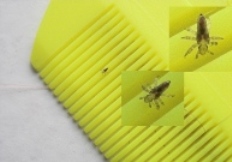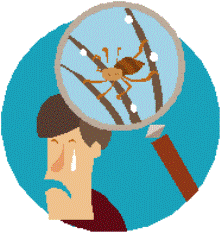Tasty Facts about Human Lice!
The reason I chose human lice, Pediculus humanus, is because I have always thought they sounded interesting. Fortunately, I have never been infected with this insect, but know many people who have been. That is why I thought it would be unique to investigate and become more educated with lice! I hope you also find this organism as interesting as I have.
~ Lice can not survive without human hair for longer than 48 hours, but they can last up to 24 hours under water.
~ Each year, about 12 million people will be infected with head lice.
 ~
There are several ways to remove human lice. Some methods
include: buying a specialized comb with small bristles to pick up
the lice as you brush your hair, vinegar can help "loosen" the lice
from the hair, alcohol is one thing that human lice can not adapt
to; pour a little on hair, there are many special types of shampoos
that are used to slowly kill the Pediculus humanus from
your body.
~
There are several ways to remove human lice. Some methods
include: buying a specialized comb with small bristles to pick up
the lice as you brush your hair, vinegar can help "loosen" the lice
from the hair, alcohol is one thing that human lice can not adapt
to; pour a little on hair, there are many special types of shampoos
that are used to slowly kill the Pediculus humanus from
your body.
~ There hasn't been a specific "type" of
person seen to be immune to catching lice, but children are most often affected
because they come in close contact with each other and may share
brushes, hair accessories, and hats.
immune to catching lice, but children are most often affected
because they come in close contact with each other and may share
brushes, hair accessories, and hats.
~Not all shampoo can kill lice because not only can they become immune, but also hold their breath, allowing them to stay alive.
~Human lice are wingless!
 ~
The size of a louse varies, depending on the age.
Nits tend to
be 0.80 mm by 0.30 mm, with an oval shape. Nymphs are about
the size of pinhead, still obtaining an oval shape. Adult louse are
larger than the nymphs, and are found to be the size of a sesame
seed. Once fully grown, females are found to become larger
than the males.
~
The size of a louse varies, depending on the age.
Nits tend to
be 0.80 mm by 0.30 mm, with an oval shape. Nymphs are about
the size of pinhead, still obtaining an oval shape. Adult louse are
larger than the nymphs, and are found to be the size of a sesame
seed. Once fully grown, females are found to become larger
than the males.
~There are roughly 400 different species of sucking lice!
~Lice, in general, haven't been found to infect whales or bats.
~The title of this webpage, "Nit-Picker's", courtesy of Dr. Tom Volk, relates to human lice because as mentioned earlier, a nit is the first stage of their lifecycle. Lice commonly cause irritation to their host, as they "pick away" in the hair and on the blood.
~Head lice can infect anyone, regardless of hygiene. The rumor is that dirty people are great homes for lice, but lice prefer clean hair to easily move through.
 ~Lice
have also been present without the signs of any symptoms, such as
itchiness. This is why doctors recommend regular head checks
for students in elementary school.
~Lice
have also been present without the signs of any symptoms, such as
itchiness. This is why doctors recommend regular head checks
for students in elementary school.
Wow, what a bunch of nit-pickers! Who made this sweet webpage? Click here to find out....